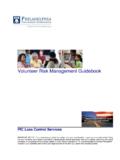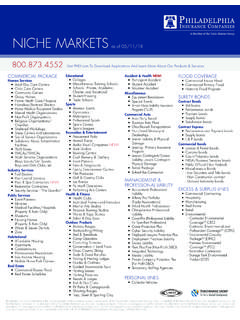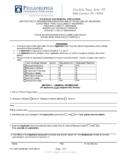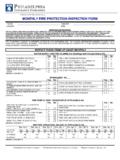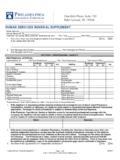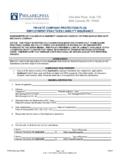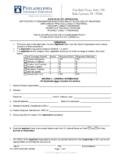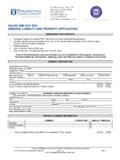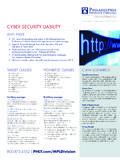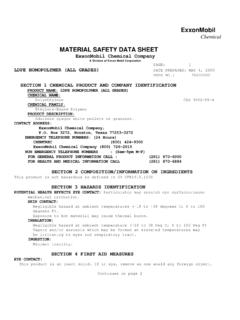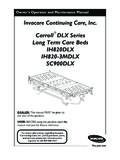Transcription of GOLF AND COUNTRY CLUB RISK MANAGEMENT GUIDEBOOK …
1 IMPORTANT NOTICE: The enclosed loss control information is for your consideration in your loss prevention efforts. They are not intended to be complete or definitive in identifying all hazards associated with your business, preventing workplace accidents, or complying with any safety related, or other, laws or regulations. You are encouraged to address the specific hazards of your business and to have your legal counsel review all of your plans and company policies. GOLF AND COUNTRY CLUB RISK MANAGEMENT GUIDEBOOK The purpose of this Risk MANAGEMENT Program is to provide our Golf and COUNTRY Club clients with information dealing with targeted areas of loss potential for all operations. Please take time to review these materials and integrate them into your ongoing loss prevention efforts at your facility.
2 If you would like additional Loss Control assistance please contact the Philadelphia Insurance Companies Loss Control Department by visiting us on the web: PIC Loss Control Services TABLE OF CONTENTS: GOLF & COUNTRY CLUB EXPOSURE 3 PROPERTY CONSERVATION CLUBHOUSE AND OTHER BUILDINGS .. 13 ADDITIONAL PROPERTY RESOURCES .. 14 EMERGENCY PREPAREDNESS .. 15 SLIPS/TRIPS/FALLS .. 16 ALCOHOL SERVER TRAINING .. 18 HEALTH AND FITNESS RISK MANAGEMENT .. 19 CHILDREN S PROGRAMING .. 20 ABUSE AND MOLESTATION PREVENTION FOR CHILDRENS PROGRAMING . 20 PLAYGROUND SAFETY .. 22 VEHICLE SAFETY .. 23 POOL SAFETY .. 26 ADDITIONAL AQUATIC RISK MANAGEMENT RESOURCES .. 28 GOLF & COUNTRY CLUB EXPOSURE INVENTORY Liability: Exposure: Struck by or contact with defective or damaged furnishings, equipment , carts, other vehicles, power sources or materials.
3 This exposure includes damage to adjoining property and persons resulting from golf balls or other projectiles and struck by lightning hazards. Controls: A. Furnishings, equipment and materials accessible to or used by the public should be in good condition and well maintained. Surfaces should be free of defects such as splinters, protruding objects and sharp edges. B. Powered equipment should be grounded or double-insulated with electrical connections and circuits protected from user contact. Electrical service in wet or high humidity areas such as pools, Jacuzzi's, spas, showers or exterior receptacles should be provided with ground fault circuit interrupter (GFCI) protection. C. Enclose all mechanical hazards such as nip points, power transmission drives, exposed electrical circuits, etc.
4 D. Protection to adjacent properties and public roadways/ thoroughfares from golf balls and other types of projectiles should be provided. Protection may include fencing, trees, walls, earthen barriers or other suitable means to contain the projectiles. E. Storm shelters equipped with lightning protection should be provided along the golf course. In addition, a warning system (horns, sirens, or voice communication) should be used to notify golfers of approaching lightning storms. Signs should be posted directing golfers to the nearest shelters. F. Picnic or outdoor cooking areas should be equipped with proper grills and non-combustible containers for the storage, containment and disposal of coals.
5 Ground fires should not be permitted. Exposure: Attractive nuisance hazards resulting from un-authorized use of the property or its facilities such as wading, swimming, fishing, sledding, snow-mobiling, ice-skating, etc. The presence of dangerous animals such as alligators or poisonous snakes increases the hazard. Controls: A. Warning signs should be posted prohibiting unauthorized and unsupervised use of the facilities and premises. Signs warning of the potential presence of dangerous animals should also be posted as necessary. Access to club facilities such as swimming pools, tennis courts, fitness centers, spas, saunas, etc. should be restricted during non-operating hours. B. Routine daily security checks of the facilities and premises should also occur.
6 Night perimeter lighting for special areas such as pools and tennis courts should be provided. Exposure: Use of premises for special gatherings, banquets, weddings, religious functions, etc. presenting a concentration of people within the building or premises, often with limited club supervision. Controls: A. Documented procedures should exist for renting or leasing facilities to others. The procedures should include a review of the size of the groups, date and time of use, and identity of designated responsible persons. A review of the appropriate rules and regulations, including emergency procedures should be made with all groups. Signed hold harmless agreements and copies of certificates of insurance showing liability coverage with limits at least equal to the club s limits should be obtained from all groups.
7 The club should be listed as an additional insured on these certificates. B. Occupant loads for the building areas to be used should be compared against the anticipated group size. Routine checks should be made of all areas designated for use by others to ensure that life safety controls exist and are operable. The reviews should also ensure that the areas are free of recognized hazards and suitable for use by others. C. Club supervision of all leased and rented facilities should be performed. The type of use anticipated should determine the degree and extent of supervision. D. Policies concerning the serving of alcohol must exist. Policies should require TIPS or its equivalent trained servers and specific hold harmless agreement for alcohol related liabilities.
8 Exposure: Operation of child care facilities on premises. Controls: A. Child care services should be limited to persons using the club facilities. Child care operations should be staffed by responsible persons trained in a Red Cross certified baby-sitting course or its equivalent. Training must include emergency evacuation procedures, first aid, CPR and general hazard recognition capabilities. Reference check and criminal background investigations should be completed for all child watch staff. B. Child care areas must be regularly monitored and visible provided with windows along walls and doors. Areas must have good lighting and sufficient exits. Electrical outlets must be protected with non-conductive plugs or caps.
9 Bathroom and closets should not have locks. Outdoor play areas should be fence enclosed. C. At least two staff persons must be present during all child care activities. Minimum staff-to child rations recommended by NFPA for life safety purposes are as follows: Number of Children Staff Ratio < 7 1:6 with no more than two children less than two years old 7-12 2:12 with no more than three children less than two years old > 12 1:3 for ages 0-2 1:5 for ages 2-3 1: 10 for ages 3-5 1: 12 for ages 5-7 1: 15 for ages 7 and over D. Staff levels recommended by the Federal Interagency Day Care regulations to provide adequate care include the following: Age of Children Staff ratio Infant to 2 years old 1 adult for every 3 children 2 to 3 years old 1 adult for every 4 children 3 to 6 years old 1 adult for every 8 children E.
10 Child care services must have policies on the following: Hours of operation and restrictions on the time a child can stay Prohibiting any type of punishment Dispensing of medications or food Handling emergencies and methods to contact parents Sign-in and sign out procedures Handling children with special needs Reporting and documenting any incidents or injuries Assisting children with personal hygiene or restroom activities F. Type, location, construction, safeguarding, and installation of play equipment and toys should be age-appropriate for the children supervised. Toys and playground equipment should meet the Consumer Products Safety Commission (CPSC) requirements. Toys and equipment should be inspected daily for damage or conditions which may cause injuries.
